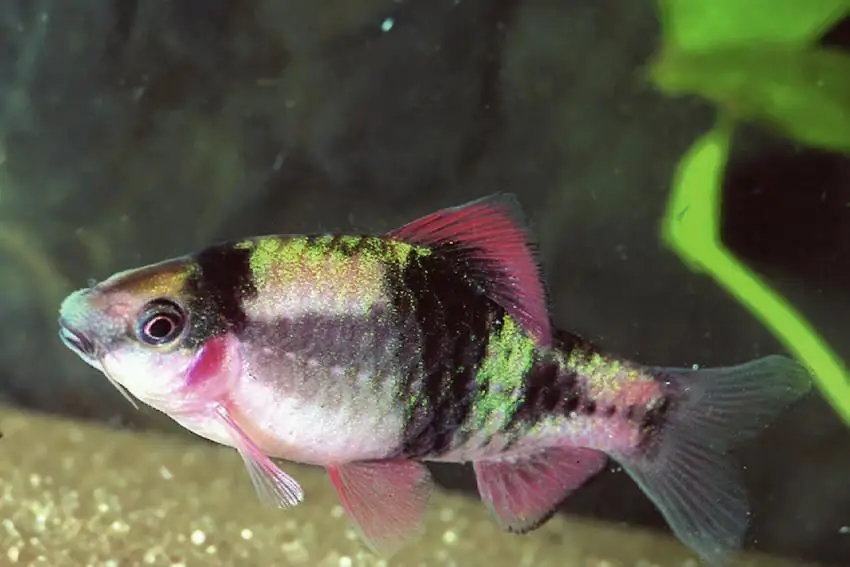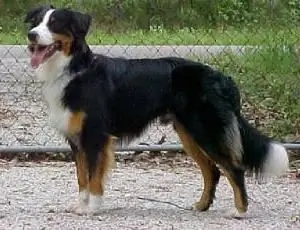2026 Author: Priscilla Miln | [email protected]. Last modified: 2025-01-22 17:55:26
The oranda goldfish is extremely popular among aquarists due to its unusual appearance. On her head she wears a growth that looks like a hat. This fish is quite sensitive to changes in conditions of detention, and therefore is not suitable for a beginner. Consider the appearance, rules of keeping and breeding features of the oranda goldfish.
General information
There are over 125 varieties of goldfish. One of their most popular and unusual representatives is the oranda goldfish. It was bred in China, from where it later spread throughout the world. Due to the large red growth on the head, this fish received another name - the little red riding hood fish.
The fish live 10-15 years, and in ideal conditions they can live up to 20 years.

Appearance
This fish outwardly stands out from other varieties of goldfish due to the huge red growth that is located on the top of the head. The growth begins to form at the age of 3months. At the age of 1-2 years, it becomes visually noticeable, and finally forms at the age of 3-4 years. The fish has an oval large body, all fins, except for the dorsal, are paired. This fish belongs to the veil-tailed ones, it has long beautiful fins. The scales of the fish shine in the light, although matte varieties exist.
Oranda goldfish can be either single color or wear different color combinations. Color combinations usually include the following colors:
- black;
- white;
- red;
- chocolate.
More recently, breeders have bred the blue color of the fish. One of the most popular colors is white with a red hood.

The body length of the fish is 5-18 cm, and it depends on the volume of the aquarium. In the pond, it can reach even more impressive sizes. The record was set in Hong Kong, where the fish reached 38 cm in length.
Features of maintenance and care
Oranda goldfish is very demanding on the conditions of detention. That is why a beginner may not be able to handle it. Her cap is vulnerable to infections and bacteria, therefore, in an insufficiently clean environment, the fish immediately begins to get sick. It is important for oranda fish that they have a lot of space. When choosing an aquarium, you should pay attention that the fish need a rectangular container with a large surface area of \u200b\u200bthe water. One fish needs an aquarium of 100 liters. Further, for each subsequent individual, 40 liters must be added to the total area. Goldfish produce a lot of waste, which is why theylarge volumes are needed, because they become contaminated more slowly. A powerful filter must function in the aquarium.
The optimum water temperature for oranda is 18-22 degrees. When the temperature drops below 16 degrees, the fish may die. Orandas love to dig in the ground, besides, they can easily injure their luxurious fins on convex and sharp scenery. For them, it is worth picking up simple smooth backgrounds without sharp ends. For soil, it is better to use finely rounded gravel.
Oranda goldfish do not like to jump out of the water, so you can do without a cover over the aquarium. They also do not need lighting, which is only important for algae in the aquarium.
Replacement of water in the aquarium must be done every week. At the same time, it is worth updating at least 30% of its volume. In a small aquarium, water changes need to be done much more often. It is very important to keep clean, clean the glass surface, soil and decorations in time.
Feeding

These are rather gluttonous and unpretentious fish. They will eat as much as you feed them. It is worth remembering that it is better to underfeed the fish than to overfeed. Fish are prone to obesity, from which they often die. The daily diet of the oranda should not exceed three percent of the weight of the fish. Feed should be poured into the aquarium as much as the fish can eat in 10-15 minutes, the rest must be removed from the tank. If the fish suddenly begins to swim, leaning on its side, this may indicate overeating. To avoid the death of a pet, it is not necessaryfeed the fish for two days.
The diet of the fish (Little Red Riding Hood) should be varied. It should include dry and live foods. From live food, you can offer: daphnia, tubifex, bloodworms, worms. For feeding aquarium fish, it is important to use special bred live food, and not caught in nature. Otherwise, infection and parasites are possible. Young animals need to be fed twice a day: in the morning and late in the evening. A single meal is enough for an adult fish.
Compatibility

The oranda goldfish is a poor swimmer and has a reputation as a scavenger. She can easily fall prey to even smaller fish. For example, guppies often eat her fins. Flickering back and forth fish will disturb the clumsy oranda goldfish. Difficulties can also arise in feeding, as you need to carefully monitor that the fish does not overeat. Although this is a peaceful inhabitant of the aquarium, it is better to settle it in a container separate from other species. It is permissible to settle with other types of egg-headed fish: telescopes, lionheads, etc.
Reproduction

Oranda goldfish reach sexual maturity at two years of age. As a spawning tank, an aquarium with a volume of 80 liters is required. It is advisable to plant small-leaved plants in it. The bottom should be sandy. Before spawning, the fish are fed live food for some time. The day before planting in the spawning ground, the fish stop feeding. After spawning, the fish must be removed from the spawning ground in order tothey didn't eat the caviar. All white unfertilized eggs should be removed from the aquarium. After five days, the first larvae begin to appear. You can start feeding them after 2-3 days, when they learn to swim. To do this, you should use special feed that is suitable for fry. When the aquarium becomes too small for the fish, they should be transplanted.
Thus, the oranda goldfish is very interesting for aquarists with its unusual appearance. This is a peaceful fish, but keeping it in an aquarium with other species is undesirable. One fish needs an aquarium of 100 liters. Little Red Riding Hood can die from overeating, so you need to carefully monitor her diet. In addition, low temperatures are deadly for her.
Recommended:
Haracin aquarium fish: description, maintenance and care

Aquarium characin fish are primarily characterized by their small size and peaceful nature. These flocking underwater inhabitants get along well with almost any neighbors and are easy to care for
Barb fish: maintenance and care, description, photo, compatibility, reproduction

Barbs can rightfully be called the favorites of the vast majority of aquarists. They are smart and agile, constantly on the move: either catching up with each other, or simply looking for something at the very bottom. They are funny and unpretentious, which, most likely, makes them so popular
East Siberian Laika: photo and description of the breed, character of the dog, features of care and maintenance, owner reviews

The East Siberian Laika, the description and photo of which will be presented in this article, has existed in its current form for about 2 centuries. Although the modern look was preceded by many modifications of the ancient types of dogs. Laiki are not a decorative breed, but their popularity has increased recently. Why are these dogs so cute for people? How to identify the breed among the rest? How to properly care for them, and how much do they cost?
Beagle: description of the breed, character, pros and cons, training, features of care and maintenance

Today, almost every family has a pet that gives its owners positive emotions. The Beagle breed is a hunting dog. As a rule, its representatives have an active and mischievous character. They are very mobile and incredibly smart, get along well with both adults and children. For more than a hundred years, this breed has occupied a leading position in the list of the most popular. How did the beagle conquer the hearts of dog breeders? Let's try to figure it out
Australian Shepherd: photo and description of the breed, character, care and maintenance

The Australian Shepherd is a smart, hardy, hardworking dog, selflessly devoted to those who care for it. Another name for the breed is Aussie. What are the characteristics and differences between these dogs? Where to get a puppy? How much does it cost? How to take care of him? How should adult Aussies be kept?

